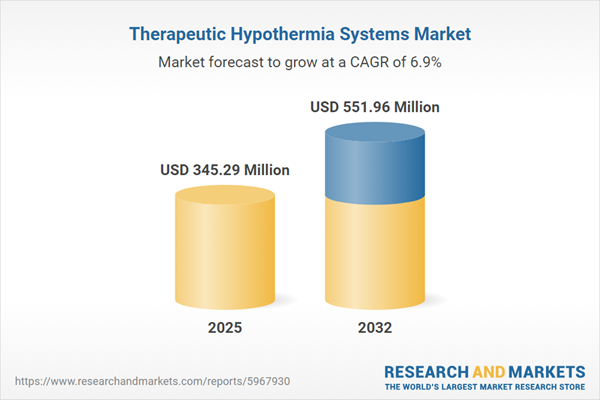Speak directly to the analyst to clarify any post sales queries you may have.
The therapeutic hypothermia systems market is experiencing sustained growth as clinical best practices, technological advancements, and shifting healthcare priorities converge to redefine standards of care in critical and emergency settings.
Market Snapshot: Therapeutic Hypothermia Systems Market
The Therapeutic Hypothermia Systems Market grew from USD 323.31 million in 2024 to USD 345.29 million in 2025. It is expected to continue growing at a CAGR of 6.91%, reaching USD 551.96 million by 2032.
This trajectory reflects the broader adoption of advanced temperature management interventions, supporting improved neurological outcomes in critical patient populations, and signals notable momentum in both device innovation and procedural adoption worldwide.Scope & Segmentation
- Product Types: Blanket systems, catheter-based platforms (including balloon-based and fluid-based catheters), ice packs and gel packs, pad systems, water circulation systems.
- Cooling Methods: Intravascular cooling, surface cooling (comprising blanket systems, ice packs and gel packs, pad systems, water circulation).
- Applications: Cardiac arrest, neonatal encephalopathy, post-surgery recovery, stroke, traumatic brain injury.
- End Users: Ambulatory care centers, homecare settings, hospitals, and specialty clinics—all shaped by unique workflow, training, and maintenance requirements.
- Temperature Control Types: Controlled temperature management (covering targeted hypothermia and targeted normothermia), and uncontrolled cooling.
- Regional Coverage: Americas (United States, Canada, Mexico, Brazil, Argentina, Chile, Colombia, Peru), Europe, Middle East & Africa (United Kingdom, Germany, France, Russia, Italy, Spain, Netherlands, Sweden, Poland, Switzerland, United Arab Emirates, Saudi Arabia, Qatar, Turkey, Israel, South Africa, Nigeria, Egypt, Kenya), and Asia-Pacific (China, India, Japan, Australia, South Korea, Indonesia, Thailand, Malaysia, Singapore, Taiwan).
- Key Companies: Stryker Corporation, C.R. Bard, Inc., ZOLL Medical Corporation, B. Braun Melsungen AG, Drägerwerk AG & Co. KGaA, Koninklijke Philips N.V., Fisher & Paykel Healthcare Corporation Limited, Haemonetics Corporation, Arizant Healthcare Inc., Cincinnati Sub-Zero Products, Inc.
Key Takeaways for Senior Decision-Makers
- Diverse product options now enable organizations to match hypothermia modalities and cooling methods to site-specific needs, leveraging both intravascular and surface approaches for broader patient eligibility.
- Regulatory updates and enhanced clinical guidelines fuel innovation—accelerating technology adoption and encouraging best-in-class integration with electronic health record infrastructure for measurable performance gains.
- Personalized protocols, supported by dynamic temperature control systems, are helping clinicians move away from one-size-fits-all treatments, thus improving both therapeutic outcomes and patient safety profiles.
- End-user environments such as hospitals, homecare, and ambulatory clinics require differentiated technology interfaces and workflow adaptations, driving vendors to invest in modular design and tailored support services.
- Regional market development is influenced by supply chain optimization, local manufacturing partnerships, and regulatory harmonization—critical for mitigating geopolitical and policy-driven uncertainties.
Tariff Impact on the Therapeutic Hypothermia Systems Market
New United States tariffs introduced in 2025 have motivated manufacturers to reevaluate global sourcing and shift toward domestic production where feasible. These developments have led to increased attention on supplier diversification, transparency, and resilience. Procurement teams are strengthening local partnerships and adjusting design strategies, while healthcare buyers are scrutinizing device value to justify capital investments—reshaping the sector’s supply chain dynamics and business models.
Methodology & Data Sources
This analysis integrates primary interviews with clinical experts and market stakeholders, supplemented by secondary research from regulatory filings, corporate reports, and patent data. Insights were validated via triangulation techniques and reinforced through attendance at industry conferences to ensure accuracy and completeness.
Why This Report Matters
- Enables clear strategic planning by mapping market opportunities across all key segments, end users, and regions.
- Supports informed purchasing and partnership decisions through analysis of regulatory trends, evolving technologies, and supply chain adaptations.
- Equips leadership with actionable intelligence to manage risk, pursue innovation, and align with value-based healthcare models.
Conclusion
The therapeutic hypothermia systems sector is poised for continued innovation and expanding global adoption. Strategic focus on modularity, personalized care, and supply resilience will be paramount for sustainable growth and improved patient outcomes.
Additional Product Information:
- Purchase of this report includes 1 year online access with quarterly updates.
- This report can be updated on request. Please contact our Customer Experience team using the Ask a Question widget on our website.
Table of Contents
3. Executive Summary
4. Market Overview
7. Cumulative Impact of Artificial Intelligence 2025
Companies Mentioned
The companies profiled in this Therapeutic Hypothermia Systems market report include:- Stryker Corporation
- C.R. Bard, Inc.
- ZOLL Medical Corporation
- B. Braun Melsungen AG
- Drägerwerk AG & Co. KGaA
- Koninklijke Philips N.V.
- Fisher & Paykel Healthcare Corporation Limited
- Haemonetics Corporation
- Arizant Healthcare Inc.
- Cincinnati Sub-Zero Products, Inc.
Table Information
| Report Attribute | Details |
|---|---|
| No. of Pages | 199 |
| Published | October 2025 |
| Forecast Period | 2025 - 2032 |
| Estimated Market Value ( USD | $ 345.29 Million |
| Forecasted Market Value ( USD | $ 551.96 Million |
| Compound Annual Growth Rate | 6.9% |
| Regions Covered | Global |
| No. of Companies Mentioned | 11 |









